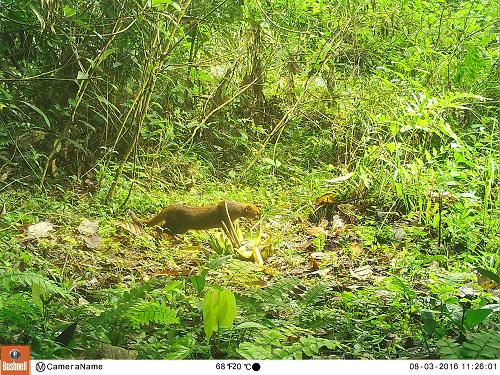Aluane Silva Ferreira
Evaluate the response of mid-sized mammals to agroforestry management intensification and variation in native forest cover surrounding the cacao agroforests

19666-1A mid-sized mammal, Jaguarundi (Puma yagouaroundi) detected in camera trap at Una city, Brazil.
Understanding how human-modified landscapes affect the biodiversity is urgent to conciliate conservation and sustainable crop production. These agroforestry systems play an important role in the conservation of regional biodiversity due to the retention of some forest characteristics (e.g. the presence of a canopy layer and of several native tree species) and to the wide extension of these plantations. Southern Bahia harbours the most extensive area of different shaded cacao plantations (locally known as cabrucas) in Brazil and corresponds to an important centre of species endemism within the Atlantic forest hotspot.
The project aims to increase our knowledge on the local fauna of agroforestry systems and how forest remnants and the management of agroforests affect the distribution of mid-sized mammals across agroforestry landscapes. We will sample mammal assemblage in 30 cabruca sites in two landscapes with different amount of forest remnants. One camera trap will be placed in each sampling site, fixed on a tree (30 cm above ground level) and will be baited with bananas and sardine. Camera trap data will be collected in four one-month surveys. In each survey, each cabrucas site will be sampled for four continuous weeks with weekly visits for camera maintenance and re-baiting. In each sampling site, vegetation variables affected by agroforestry management intensification and thought to be important for mammals will be quantified. The vegetation and land-use will be described around each sampling site using landscape metrics, describing the amount of habitat and diversity of the landscape elements. The record rate of each mammal species by site will be used to evaluate the response of common species (population analyses) and of species assemblages (community analyses) to the environmental data collected. By comparing the mammal responses among contrasting landscapes, we will understand if the responses to vegetation structure and local landscapes are contexts dependent, i.e. dependent on the total amount of forest in the broad landscape. This study will contribute to a better understanding of the ecological processes that control the local diversity of mammals. Such processes may operate at different scales: local (agroforestry management related to habitat quality), intermediate (forest around the agroforest site functioning as the source area) and large (influence of forest cover in the overall landscape, interfering with the maintenance of viable populations and the regional species pool).